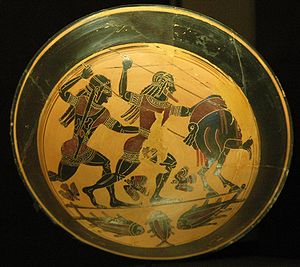
Naucratis Painter
Encyclopedia

Laconia
Laconia , also known as Lacedaemonia, is one of the regional units of Greece. It is part of the region of Peloponnese. It is situated in the southeastern part of the Peloponnese peninsula. Its administrative capital is Sparti...
n vase-painter of the mid-sixth century BCE. Naucratis
Naucratis
Naucratis or Naukratis, , loosely translated as " power over ships" , was a city of Ancient Egypt, on the Canopic branch of the Nile river, 45 mi SE of the open sea and the later capital of Ptolemaic Egypt, Alexandria...
was a Greek trading post (emporion
Emporia (ancient Greece)
Emporia, sing emporion were places which the traders of one nation had reserved to their business interests within the territory of another nation. Famous emporia include Sais where Solon went to acquire the knowledge of Egypt, Elim where Hatshepsut kept her Red Sea fleet...
) in Egypt. Two fragments of a kylix
Kylix (drinking cup)
A kylix is a type of wine-drinking glass with a broad relatively shallow body raised on a stem from a foot and usually with two horizontal handles disposed symmetrically...
found in the Demeter Sanctuary, Cyrene
Cyrene, Libya
Cyrene was an ancient Greek colony and then a Roman city in present-day Shahhat, Libya, the oldest and most important of the five Greek cities in the region. It gave eastern Libya the classical name Cyrenaica that it has retained to modern times.Cyrene lies in a lush valley in the Jebel Akhdar...
, show that the Naucratis Painter was literate, and the form of a three-stroke iota
Iota
Iota is the ninth letter of the Greek alphabet. In the system of Greek numerals it has a value of 10. It was derived from the Phoenician letter Yodh . Letters that arose from this letter include the Roman I and J and the Cyrillic І , Yi , Je , and iotified letters .Iota represents...
suggests, moreover, that he was a foreigner in Laconia.
Further reading
- Lane, E.A., 'Lakonian Vase Painting', Annual of the British School at Athens 34 (1933/34) 99-189.
- Pipili, M., Laconian Iconography (1987).
- Stibbe, C.M., Lakonische Vasenmaler des sechsten Jahrhunderts vor Christus (Amsterdam, 1972).
- Stibbe, C.M., Laconian Drinking Vessels and Other Open Shapes (Amsterdam, 1994).

